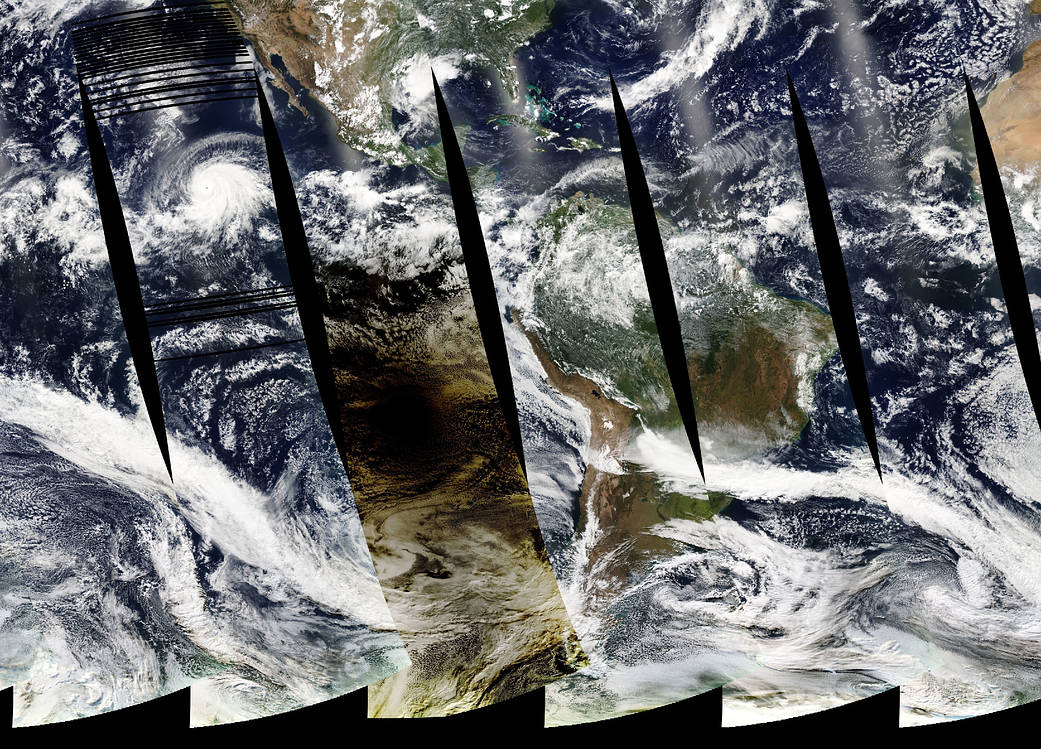2019年7月2日,当地时间下午4点38分,智利海滨城市拉塞丽娜的天文爱好者抬头看到天空中有一个黑色的圆圈。天空的其余部分笼罩在橙色的暮色中,地面附近的温度暂时下降了几度。这并不是世界末日的征兆,而是一次日全食——当月亮直接经过地球和太阳之间,完全遮住了日冕。
当日食追踪者向上看的时候,NASA的卫星向下看地球表面。Aqua卫星上的中分辨率成像光谱仪(MODIS)传感器捕捉到了这张月球阴影向东穿越南太平洋的照片。日蚀投下的阴影由完全变暗的阴影和部分变暗的半影组成。
Aqua卫星有一个极地轨道,MODIS传感器收集的图像宽约2330公里(1450英里)。这幅图像是由三次不同时间采集的数据拼接而成的。图像的左三分之一是在宇宙时间21:40,在日全食之后拍摄的。中间的狭长地带是在世界时间20:00左右拍摄的,当时日全食正在南太平洋上空。右边的第三张图显示的是智利在世界时间18:13到18:32之间(当地时间下午2:13到2:32),在日全食之前拍摄的。图像中的黑色间隙是赤道(地球最宽点)附近的地方,MODIS的拍摄区域在某一天内不会相交。
当月球的直径比恒星小400倍时,它是如何遮住太阳的呢?这是因为月球的轨道。月球绕地球运行的轨道略呈椭圆形,就像一个以地球为中心的扁圆。因此,月球与地球的距离并不总是相同的。当月球离地球最近时,它会比离地球较远时略大一些。在日全食期间,月球离地球的距离是太阳离地球距离的400倍,这抵消了月球直径相差400倍的影响。
从一个特定的位置看到日全食是很罕见的。平均来说,地球上相同的地点大约每375年就会发生几分钟的日食,尽管地球上的某个地方大约一年半就会发生一次日全食。下一次日全食将于2020年12月14日发生在南太平洋、智利、阿根廷和南大西洋上空。下一次在北美出现的日全食将发生在2024年4月8日。
On July 2, 2019, skywatchers in the beach city of La Serena, Chile, looked up at 4:38 p.m. local time to see a black circle in the sky. The rest of the sky was shaded in orange twilight, and the temperature near the ground momentarily dropped by a few degrees. It wasn’t a sign of the apocalypse, but a total solar eclipse—when the Moon passes directly between the Earth and the Sun and completely obscures the disk.
As eclipse chasers were looking up, NASA satellites were looking down at Earth’s surface. The Moderate Resolution Imaging Spectroradiometer (MODIS) sensor on the Aqua satellite captured this view of the Moon’s shadow as it traveled eastward across the South Pacific. The shadow cast by an eclipse consists of the completely darkened umbra and the partially shadowed penumbra.
Aqua has a polar orbit and the MODIS sensor collects imagery in swaths that are roughly 2,330 kilometers (1,450 miles) wide. This image is a mosaic comprised of data collected at three different times. The left third of the image was collected at 21:40 Universal Time, after the shadow had passed. The middle swath was captured at about 20:00 Universal Time, when the eclipse was in progress over the South Pacific. The right third shows Chile between 18:13 to 18:32 Universal Time (2:13 to 2:32 p.m. local time), before the shadow passed. The black gaps in the image are places near the Equator (Earth’s widest point) where MODIS swaths do not meet on a given day.
How is the Moon able to obscure the Sun when it is 400 times smaller in diameter than the star? It’s all about the Moon’s orbit. The Moon travels around Earth in a slightly elliptical path—like a squashed circle with the Earth at its center. As a result, the Moon is not always the same distance from the Earth. When it is closest, the Moon appears slightly larger than when it is far away. During a total solar eclipse, the Moon is 400 times closer to Earth than the Sun is to Earth, offsetting the 400 times difference in diameter.
Seeing a total solar eclipse from a particular location is rare. On average, the exact same spot on Earth sees a solar eclipse for a few minutes about every 375 years, although a total eclipse happens about every year and a half somewhere on Earth. The next total solar eclipse will occur on December 14, 2020, over the South Pacific, Chile, Argentina, and the South Atlantic. The next total solar eclipse to make an appearance in North America will be on April 8, 2024.
Image Credit: NASA/Lauren Dauphin; Text Kasha Patel







